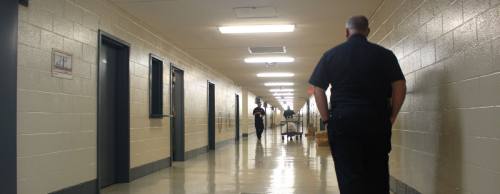Hays County Judge Bert Cobb is fond of a story about the Hays County Jail. When former County Judge Don Rains cut the ribbon at the current jail at 1307 Uhland Road, San Marcos, in 1989, he told the crowd it was time to start planning for a new one.
Now, 27 years later, the Hays County Commissioners Court has decided it has done plenty of planning and announced in April it will put a bond on the November ballot. If approved the bond would fund construction of a new jail, law- enforcement center and co-located communications center that would house the communications staff of each emergency-response entity in the county.
Aside from having served the county’s law enforcement needs for almost three decades, the current jail is running out of capacity to accommodate the inmate population in Hays County, which is projected to be the fastest-growing county in Texas by 2050, according to the Office of the State Demographer.
“We’d love to say our inmate population is going down,” Sheriff Gary Cutler said. “[The information] we’re following does not show that happening. The way the growth is here, I mean, that’s a concern, that it’s not going to go down.”
The current county jail is a 362-bed facility, but because of federal and state regulations dictating how inmates must be housed, the actual number of beds available to inmates is closer to 300. As of May 10 there were 314 Hays County inmates at the jail and an additional 77 being housed in Bastrop, Caldwell, Guadalupe and Walker counties.
Rising jail population
Since discussions about a new jail began in the late 2000s, the county’s population has increased each year, but the jail’s population remained relatively stable for much of the early 2010s, mostly because of a series of initiatives set in place by the sheriff’s office.
A system of work credits was created to allow inmates who contribute to the upkeep of the jail and participate in trash cleanups on county roads to reduce their sentences.
Additionally, police chiefs in Kyle, Buda and San Marcos have been given the option to write citations for certain misdemeanors that once required offenders to be taken to the jail for processing. Those who receive citations are made to appear in court at a later date for sentencing that could include jail time. In 2013, officials issued 103 citations for offenses ranging from possession of less than 4 ounces of marijuana to theft of items valued at less than $500, according to the sheriff’s office.
Despite implementation of the work credit and citation programs, the inmate population at the jail has risen to the point that the county began outsourcing prisoners to other counties in 2014 after discontinuing the practice in 2011.
Operational efficiency
Jailing practices have changed significantly since the Hays County Jail was opened in 1989, Cutler said. The jail was built to accommodate a practice popular in the 1980s known as “indirect supervision,” which involves inmates being separated from guards by multiple walls.
Under indirect supervision guards are required by state law to check an inmate’s status every 15 minutes if the inmate is suicidal, 30 minutes if they are housed in a segregation unit and every hour if they are part of the general population, said Captain Mike Davenport of the Hays County Sheriff’s Office.
“Right now we have guys and that is all they do,” he said. “They make circles opening doors and opening doors to look at [inmates]. That’s very labor-intensive.”
If a new jail is built, its layout will accommodate direct supervision, which removes walls between guards and inmates and has less strict requirements for how often guards must check on inmates.
The practice has been adopted by many other communities throughout the nation, and Cutler and Davenport said they do not anticipate any elevated risk to their guards.
The booking area at the current jail is too small to handle the number of inmates that pass through the system each day, too, Davenport said. If a new facility was built, a larger area for booking would be a necessity, he said.
The bond
Commissioners Will Conley and Debbie Gonzales-Ingalsbe, as well as county staff members and representatives from the Hays County Sheriff’s Office, have formed a bond committee to determine the project’s cost and scope of work.
According to a study presented to commissioners March 22, the county should plan to build a new facility with 462 beds. That estimate put the rough cost of building a new jail at about $52.47 million without including the cost of constructing the new law-enforcement and co-located communications centers.
Conley said he believes the number of beds at the new facility should be somewhere between 450-600.
“The question is … ‘How do we build something that’s going to be responsible?’” Conley said. “[How do we build something] that’s not going to be full day one, but it’s also not going to be overbuilt? We don’t want to put ourselves in the position of some other counties that have half a jail facility empty.”
The bond committee will release a request for bids to construction companies early this summer, and Conley said he expects to have bids ready for review by mid-summer.
If the bond is rejected, Conley said the county will have to figure out a solution to the problem that does not involve asking voters for money. He said he would not support issuing certificates of obligation—a form of debt that does not require voter approval—if the November bond fails.
“We will have to make do,” he said. “We will have to have a hodgepodge [of jail maintenance and repairs] until the county is prepared a year or two afterwards to go back to the people and have that discussion again.”







